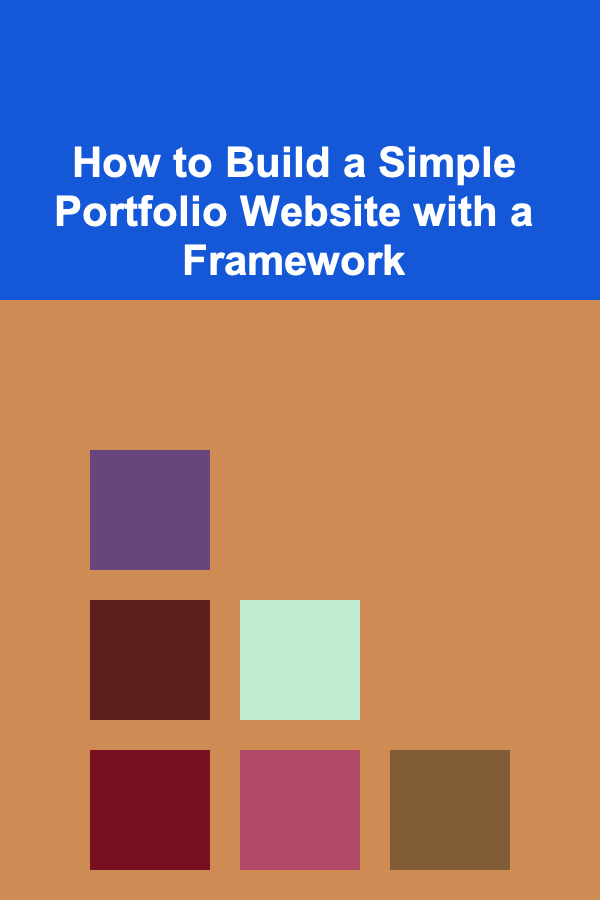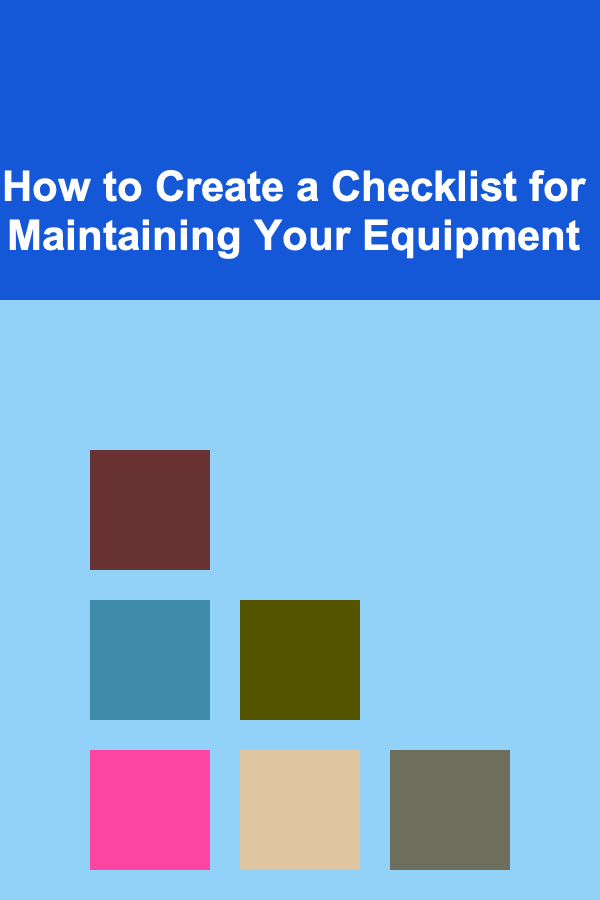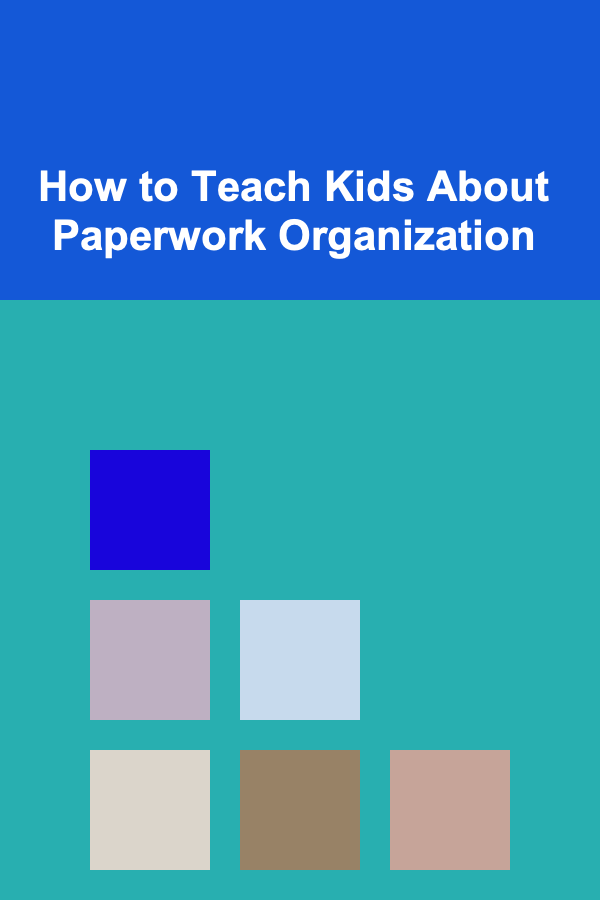
How to Build a Simple Portfolio Website with a Framework
ebook include PDF & Audio bundle (Micro Guide)
$12.99$8.99
Limited Time Offer! Order within the next:

In today's digital age, a well-designed portfolio website is an essential tool for showcasing your skills, projects, and achievements to potential clients, employers, and collaborators. Whether you're a web developer, designer, photographer, or any other professional, having an online presence can help you stand out in a crowded marketplace.
Building a portfolio website doesn't need to be an overwhelming task. With the use of modern web development frameworks, you can quickly create a clean, functional, and professional portfolio. In this article, we will guide you through the steps of building a simple portfolio website using a framework, specifically React.js, one of the most popular frameworks for building user interfaces.
Why Use a Framework?
A framework provides the foundation and tools needed to build a structured web application. Instead of starting from scratch, using a framework helps you save time, avoid redundant code, and follow best practices. Frameworks also come with built-in functionalities, libraries, and tools that speed up the development process and ensure your website is scalable and maintainable.
For portfolio websites, frameworks like React.js allow you to create reusable components, manage state, and implement interactive features efficiently. React is known for its fast rendering, component-based architecture, and vast ecosystem, making it an ideal choice for building modern portfolio websites.
Prerequisites
Before you start building your portfolio website, you should have a basic understanding of the following:
- HTML/CSS: Basic knowledge of HTML for structuring the content and CSS for styling the website.
- JavaScript: Familiarity with JavaScript will help you understand how React works and how you can add interactivity to your portfolio.
- Node.js and npm: React requires Node.js to run. npm (Node Package Manager) is used to install dependencies and manage packages.
- Basic Git: Understanding Git is helpful for version control and collaborating on projects.
Setting Up Your Development Environment
Step 1: Install Node.js
First, you need to install Node.js, which is required to run JavaScript on the server-side and manage project dependencies.
-
Go to Node.js official website and download the latest version of Node.js.
-
Install Node.js by following the prompts for your operating system.
-
After installation, verify that Node.js is installed by running the following command in your terminal:
This will print the installed version of Node.js.
Step 2: Create a React App
React provides a tool called Create React App, which simplifies the process of setting up a React project by creating a project structure and configuration for you. To create a new React app:
-
Open your terminal and run the following command:
Replace
my-portfoliowith the desired name for your portfolio website. -
Once the installation is complete, navigate to the newly created project folder:
-
Start the development server to see the default React app running in your browser:
This will open a new tab in your browser with the React app running locally at
http://localhost:3000.
Step 3: Install Dependencies
To enhance the functionality of your portfolio website, you may need to install additional libraries and tools. Some commonly used libraries for React development include:
- React Router: For adding routing and navigation to different pages.
- Styled Components: For styling your components using JavaScript.
- React Icons: For adding icons to your portfolio.
You can install these dependencies by running:
Building the Portfolio Website
Now that the environment is set up, let's begin building the components of your portfolio website. A simple portfolio website typically includes the following sections:
- Home: An introduction with a brief overview of who you are and what you do.
- About: A more detailed section about your background, skills, and experience.
- Projects: A showcase of your work, including links to live projects or GitHub repositories.
- Contact: A contact form or a section with links to your social media and professional profiles.
Let's go step by step to build each section.
Step 4: Creating Components
1. Home Page Component
The Home page will greet visitors and give them an overview of who you are. You can create a new file called Home.js in the src folder:
import './Home.css'; // import CSS file for styling
const Home = () => {
return (
<div className="home">
<h1>Welcome to My Portfolio</h1>
<p>Hi, I'm [Your Name], a passionate web developer. I specialize in building beautiful and functional websites using modern technologies like React.js.</p>
</div>
);
};
export default Home;
Here, we use a simple h1 and p tag to introduce yourself. In the Home.css file, you can add some basic styling:
text-align: center;
padding: 50px;
background-color: #f4f4f4;
}
.home h1 {
font-size: 2.5rem;
color: #333;
}
.home p {
font-size: 1.2rem;
color: #666;
}
2. About Page Component
Next, create an About page where you share more details about your professional background. Create a file called About.js:
import './About.css';
const About = () => {
return (
<div className="about">
<h2>About Me</h2>
<p>I'm a full-stack developer with expertise in React.js, Node.js, and web technologies. I have worked on various projects ranging from e-commerce websites to personal blogs.</p>
</div>
);
};
export default About;
In the About.css file, you can add the following styles:
padding: 50px;
background-color: #ffffff;
text-align: center;
}
.about h2 {
font-size: 2rem;
color: #333;
}
.about p {
font-size: 1.2rem;
color: #666;
}
3. Projects Page Component
Your Projects section will showcase your work. Create a Projects.js file:
import './Projects.css';
const Projects = () => {
return (
<div className="projects">
<h2>My Projects</h2>
<div className="project">
<h3>Project 1</h3>
<p>A brief description of your first project.</p>
</div>
<div className="project">
<h3>Project 2</h3>
<p>A brief description of your second project.</p>
</div>
</div>
);
};
export default Projects;
And the corresponding Projects.css:
padding: 50px;
background-color: #f9f9f9;
}
.projects h2 {
text-align: center;
font-size: 2rem;
color: #333;
}
.project {
margin: 20px 0;
}
.project h3 {
font-size: 1.5rem;
color: #333;
}
.project p {
font-size: 1rem;
color: #666;
}
4. Contact Page Component
Create a simple Contact page where visitors can reach out to you. For now, let's add links to your social media profiles:
import './Contact.css';
const Contact = () => {
return (
<div className="contact">
<h2>Contact Me</h2>
<p>You can reach out to me on the following platforms:</p>
<ul>
<li><a href="https://linkedin.com">LinkedIn</a></li>
<li><a href="https://github.com">GitHub</a></li>
</ul>
</div>
);
};
export default Contact;
In Contact.css, style the contact section:
padding: 50px;
background-color: #fff;
text-align: center;
}
.contact h2 {
font-size: 2rem;
color: #333;
}
.contact ul {
list-style-type: none;
}
.contact li {
font-size: 1.2rem;
}
.contact a {
text-decoration: none;
color: #0073e6;
}
Step 5: Add Routing with React Router
React Router allows you to navigate between pages without reloading the whole page. In your App.js file, add routes to link the pages together:
import { BrowserRouter as Router, Route, Switch } from 'react-router-dom';
import Home from './Home';
import About from './About';
import Projects from './Projects';
import Contact from './Contact';
import './App.css';
const App = () => {
return (
<Router>
<div className="App">
<nav>
<ul>
<li><a href="/">Home</a></li>
<li><a href="/about">About</a></li>
<li><a href="/projects">Projects</a></li>
<li><a href="/contact">Contact</a></li>
</ul>
</nav>
<Switch>
<Route path="/" exact component={Home} />
<Route path="/about" component={About} />
<Route path="/projects" component={Projects} />
<Route path="/contact" component={Contact} />
</Switch>
</div>
</Router>
);
};
export default App;
Step 6: Final Styling and Optimization
Once your pages and routing are set up, you can enhance the design with modern CSS techniques like flexbox, grid layouts, and animations. Consider using CSS modules or Styled Components to scope your styles and make the app more maintainable.
Conclusion
Building a simple portfolio website with a framework like React is an excellent way to showcase your skills and projects to the world. By using a modern JavaScript framework, you can create a responsive, fast, and dynamic website that stands out to potential employers or clients.
Remember to follow best practices, keep the website clean and minimalistic, and focus on usability. With React, you can easily expand the functionality of your portfolio website, whether by adding a blog, integrating APIs, or building more interactive features.
By taking the time to build your portfolio website, you're investing in your personal brand and providing an accessible way for others to learn about your work and connect with you. Happy coding!
Reading More From Our Other Websites
- [Personal Care Tips 101] How to Exfoliate Your Face in the Morning for a Fresh Start
- [Home Security 101] How to Use Motion-Activated Lights to Deter Intruders and Enhance Safety
- [Organization Tip 101] How to Store Holiday Wreaths Without Damage
- [Personal Care Tips 101] How to Choose a Facial Cleanser with Natural Ingredients
- [Organization Tip 101] How to Streamline Check-In Processes for Guests
- [Sewing Tip 101] 10 Must-Know Sewing Techniques Every Wardrobe Designer Should Master
- [Home Cleaning 101] How to Clean Up After a Small Home Renovation
- [Home Soundproofing 101] How to Install Soundproofing in Your Apartment Without Permanent Changes
- [Horseback Riding Tip 101] Building a Strong Seat: Tips for Balance and Core Strength in the Saddle
- [Organization Tip 101] How to Build a Compact Tool Storage Unit

5 Common Mistakes to Avoid When Applying for Remote Positions
Read More
How to Build a Checklist for Monitoring Website Analytics
Read More
How to Choose the Best Security System for Your Budget
Read More
How to Create a Checklist for Maintaining Your Equipment
Read More
How to Teach Kids About Paperwork Organization
Read MoreHow to Integrate Your Bank Accounts with Your Expense Tracker for Tax Season
Read MoreOther Products

5 Common Mistakes to Avoid When Applying for Remote Positions
Read More
How to Build a Checklist for Monitoring Website Analytics
Read More
How to Choose the Best Security System for Your Budget
Read More
How to Create a Checklist for Maintaining Your Equipment
Read More